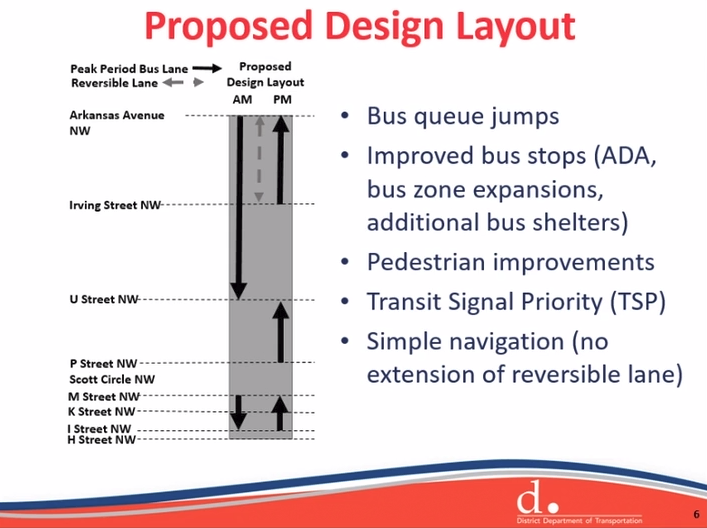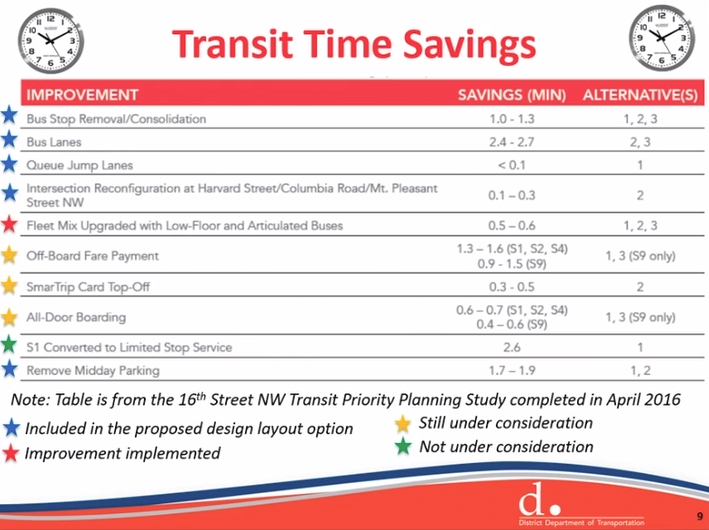Here’s where bus lanes may one day speed up your ride on 16th Street

Busing down 16th Street by truthaboutit licensed under Creative Commons.
During rush hours, buses on 16th Street will be able to bypass traffic in a bus lane, hopefully by 2020. On some of the street, anyway.
Planners from the District Department of Transportation (DDOT) unveiled their design for bus lanes on 16th Street, the next step from a 2016 planning study which recommended a dedicated bus lane in the peak direction during the peak period, as well as a number of other changes to make the 16th Street buses faster and more reliable.
From 7 to 10 am, southbound buses would have a bus lane all the way from Arkansas Avenue to U Street. They would then merge into traffic through Dupont and under Scott Circle, and have a bus lane again from M Street to I Street.
Northbound from 4 to 7:30 pm, buses will get a dedicated lane from I Street to M, then no bus lane under Scott Circle, then again from P to U, none up the hill to Columbia Heights, and in a lane again from Irving Street to Arkansas Avenue.
The case for bus lanes is perhaps nowhere stronger than than 16th Street. Buses carry over 50% of the people on 16th even though only 3% of the vehicles are buses. Bus lanes could save WMATA millions in operating costs, either cutting the cost to taxpayers or affording more service.
DDOT hopes to have the lane in operation in 2020, which is about the same as the four-year timeframe the 2016 study proposed.
There are many more details
DDOT planners have developed a lot more specifics about how they think they can make this work. Watch the full online presentation for the details. There will be queue jump lanes, where the bus can pull out of traffic and then get started when the light turns green before other cars, at M, U, and Harvard streets heading north and at M Street heading south.
Left turns will not be allowed at some intersections (and there will be a new southbound left-turn lane at Harvard Street). A few bus stops will go away where they are very close to other bus stops. Each stop adds time, so there is an important balance between having stops where people need them but not too many.
According to the DDOT presentation, 16th Street already has signal priority, where yellow lights hold a little longer to let a bus pass, at all 33 traffic lights on 16th Street. However, this only activates when buses are running behind schedule right now.
The study also recommended all-door boarding, where people can get on through the rear door, and off-board fare collection, where people pay before the bus arrives. Both are ways to speed up the bus by saving time on people boarding. These require more coordination between DDOT and WMATA so DDOT will be deferring these for a later project, officials said in a presentation to stakeholders.
Why not dedicated lanes in more places?
If you were involved in earlier iterations of this process, you may remember there was more bus lane back then. What happened?
The 2016 study recommended the bus lane cover the entire length of 16th Street south of Arkansas Avenue, souhbound in the morning and northbound in the evening. To make that work, the study said the reversible lane north of Columbia Heights would extend down to O Street. In the Dupont/Logan area, the current four wide lanes would become five narrower ones.
However, the study also said more detailed work was necessary to ensure these are feasible and flesh out the ideas.
It's common for a planning study to stop at a higher level and for a subsequent design study to take over. When officials looked closer, however, they realized that there wasn't room for five lanes in Dupont.
The reversible lane could still stretch down to U Street, since 16th Street is five lanes for most of this length. However, planners concluded they would need two pairs of overhead displays like the ones on the reversible lanes in Siver Spring, which show drivers what lanes they can use. That's because at U Street and Harvard Street, the intersections are complex enough that it wouldn't be totally clear where to go.
However, federal and local historic preservation agencies, and some local community groups, objected on preservation grounds. 16th Street is the “road to the White House” and a major corridor in the L'Enfant Plan. They argued that it wasn't historically appropriate to have overhead signs across 16th Street — even in just two places.
DDOT could pursue a “Section 106” analysis, sort of like an Environmental Impact Statement, to consider affecting a historic resource. It would take years, and there would be no guarantee the outcome would allow the gantries then. Or, it could cut out a few of the lane segments, do without the reversible lane, and get the project built on time in 2020.
Also, reversible lanes aren't great. People along Connecticut Avenue would like to get rid of theirs. So it wasn't ideal to add more reversible lanes.
Preservation just cost eight hours of your life
Even so, these objections to two overhead signs point to how historic preservation trumps all other considerations in DC.
Depending on the alternative and which bus line you look at (S1, S2, S4, S9), the planning study estimated people would save about 3.7-5.7 minutes southbound in the morning peak and 4.6-5.8 minutes northbound in the evening. Average these numbers (that's not scientific, but bear with me) and you get about 4.9 minutes.
According to one DDOT presentation, the savings now are about 1.9-2.6 minutes in the am and 1.8-3.2 minutes in the pm, for an average of 2.4 minutes. That's 2.5 minutes less.
Now, that's not all the reversible lane. The planning study included a lot of other operational improvements, like paying before boarding and using all doors, rebalancing more stops, and more. But let's say just one minute each way of the 2.5 minutes is due to the lane configuration.
If you ride the bus each day two ways to work and not any other times, let's say 48 weeks a year, that's 480 trips a year or eight hours of your life, each year, which will be spent in traffic instead of sleeping or being with family or something. In 2013, there were 20,500 rides on the 16th Street lines, or 82,000 hours people lost.
Because of just two overhead gantries. Think about it.
This design isn't everything advocates wanted, but it's worth supporting
Weighing everything together, it seems like DDOT officials made the smart call here. They can get the project done and save people time.
After all, if losing one minute of each bus trip due to the reversible lane costs you eight hours a year, that also means that 2.4 minute time savings per bus trip overall saves you 20 hours a year of your life. So, yay! And 196,800 hours saved for everyone!
Sure, saving 40 hours a year in the original plan would have been even better — twice as good! And that's a whole week!
Could it be better? Well, there could be a full-length, peak-period bus lane and no reversible lane. That would mean reducing 16th Street from two car lanes to just one in the peak period. That's certainly best for transit. The 2016 study looked at the idea, but found that traffic backups would extend across multiple intersections and cause a lot of drivers to divert through other nearby streets.
Even if DDOT did pursue this, the team felt they would have to go through a much more complex analysis, similar to an Environmental Assessment, before being able to have that kind of effect on traffic. And similarly, there would be no guarantee of approval in the end.
If these half-lanes are a success, then that could build political support for extending them further, even if more delays for car drivers is a consequence.
Will this succeed?
Let's hope what they build does succeed. Having the lanes for only part of the way definitely could make it more likely for drivers to invade the lanes, and bus riders might find themselves still stuck in traffic and thus annoyed anyway. There's some danger the compromises will make this less likely to make a storng case for more lanes here and elsewhere.
On the other hand, from DDOT planners' point of view, without the compromises it would be years or more to get lanes at all.
Plus, these lanes are adding 3.35 miles of one-way bus lanes to DC. Right now DC only has one 0.3-mile two-way bus lane on Georgia Avenue near Howard University. That means this project would increase the total bus lanes by a factor of about 5.5.
It can be hard to get excited about a project which delivers half of what it could be doing. But, it's still not for certain this half will happen. For one thing, some parking spaces have to go, and parking is often the sure-fire way to bring out neighborhood opponents.
16th Street would not have any parking during the am and pm peaks, whereas now drivers can park on the non-peak side of the street. About 20 parking spaces would go away during the middle of the day, and DDOT might want to expand some bus stops to help improve bus flow, which could imperil 35 more parking spaces.
It'll require advocates to keep pushing for this lane, and hard, to get it over the finish line, even for 3.35 one-way miles instead of a potential 5.4 (Arkansas to H, both ways). Even though it's disappointing we can't push for the full thing.
Tell us what you think about the bus lanes plan
We do realize there's some good and some bad, here, and there may be a variety of feelings from our community. So, we're interested in your thoughts via this little survey. (Click here if you can't see the embedded version below.) And discuss in the comments!





